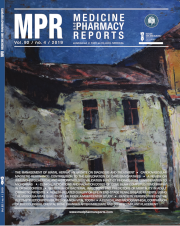A review on immunohistochemical and histopathologic validation in PET-CT findings with consideration to microRNAs
DOI:
https://doi.org/10.15386/mpr-1341Keywords:
histopathology, immunohistochemistry, Positron Emission Tomography Computed Tomography, microRNAs, neoplasmsAbstract
Purpose. This review provides an overview of some of the most recent clinical trials which investigated various types of cancer and other diseases, through the use of PET-CT imaging, highlighting the use of immunohistochemical stains or conventional histopathology for the validation or contradiction of their hypothesis. Furthermore, we investigate a potential new direction of research by analyzing the upcoming role of microRNAs in disease confirmation.
Methods. An extensive search of MEDLINE/ PubMed and SCOPUS electronic databases was made, using the MeSH terms "positron emission tomography computed tomography" and "immunohistochemistry" as well as ”SUV” and ”immunohistochemistry”, restricting the search by clinical trials and time period. Further searches were made for articles regarding Ki-67 and microRNAs in correlation with metabolic PET-CT uptake.
Results. Out of all 389 initial search results, 27 original articles were found relevant to the topic. Their contents were synthesized and discussed regarding the matter at hand. No relevant clinical trials involving microRNAs were found.
Conclusions. Immunohistochemical and histopathologic results remain widely used and indispensable in modern research, concerning PET-CT validation. Possible candidates for diagnosis confirmation, in future research, may reside in the further development of microRNAs.
Downloads
Published
How to Cite
Issue
Section
License
The authors are required to transfer the copyright of the published paper to the journal. This is done by agreeing to sign the Copyright Assignment Form. Whenever the case, authors are also required to send permissions to reproduce material (such as illustrations) from the copyright holder.

The papers published in the journal are licensed under a Creative Commons Attribution-NonCommercial-NoDerivatives 4.0 International License.

